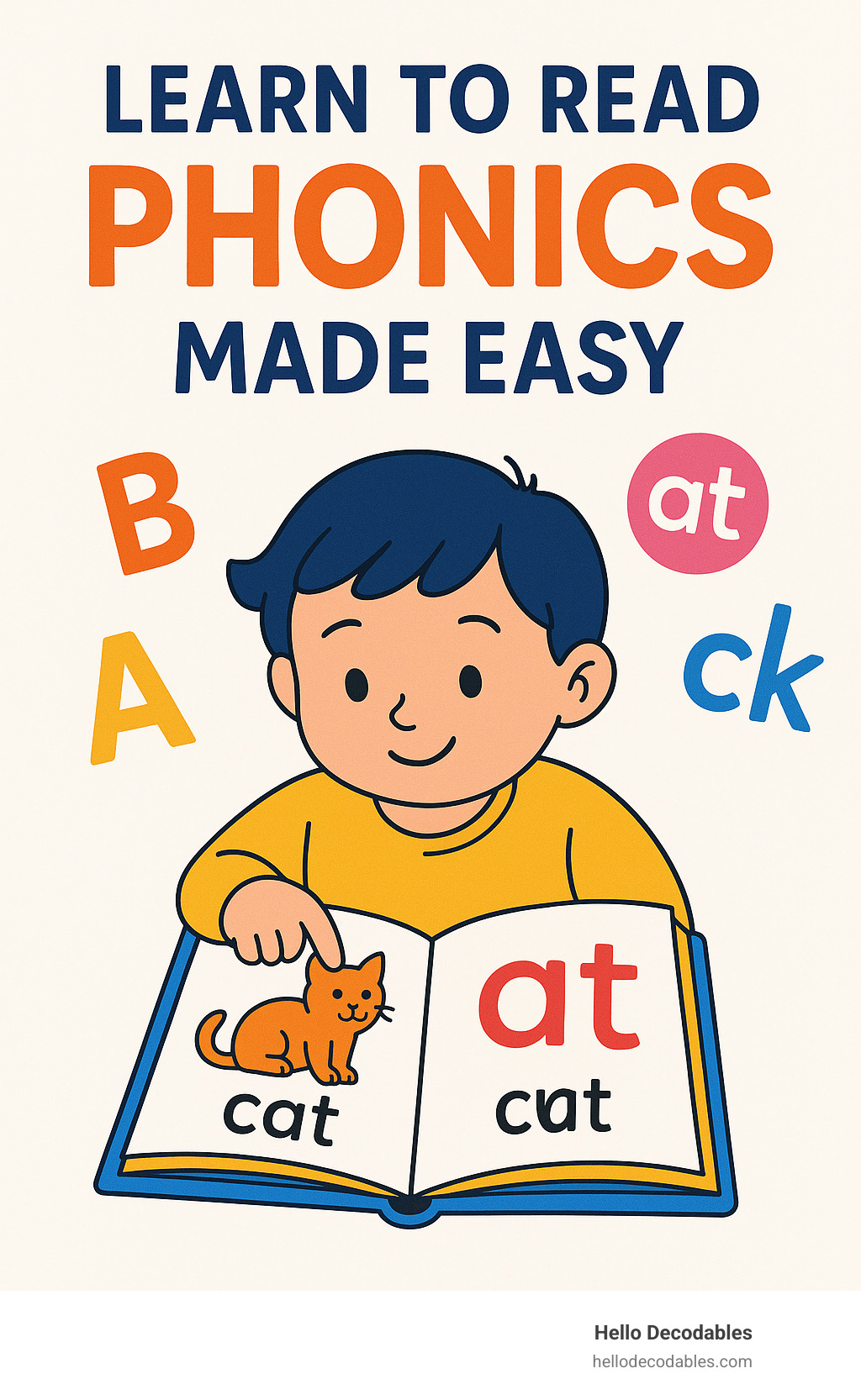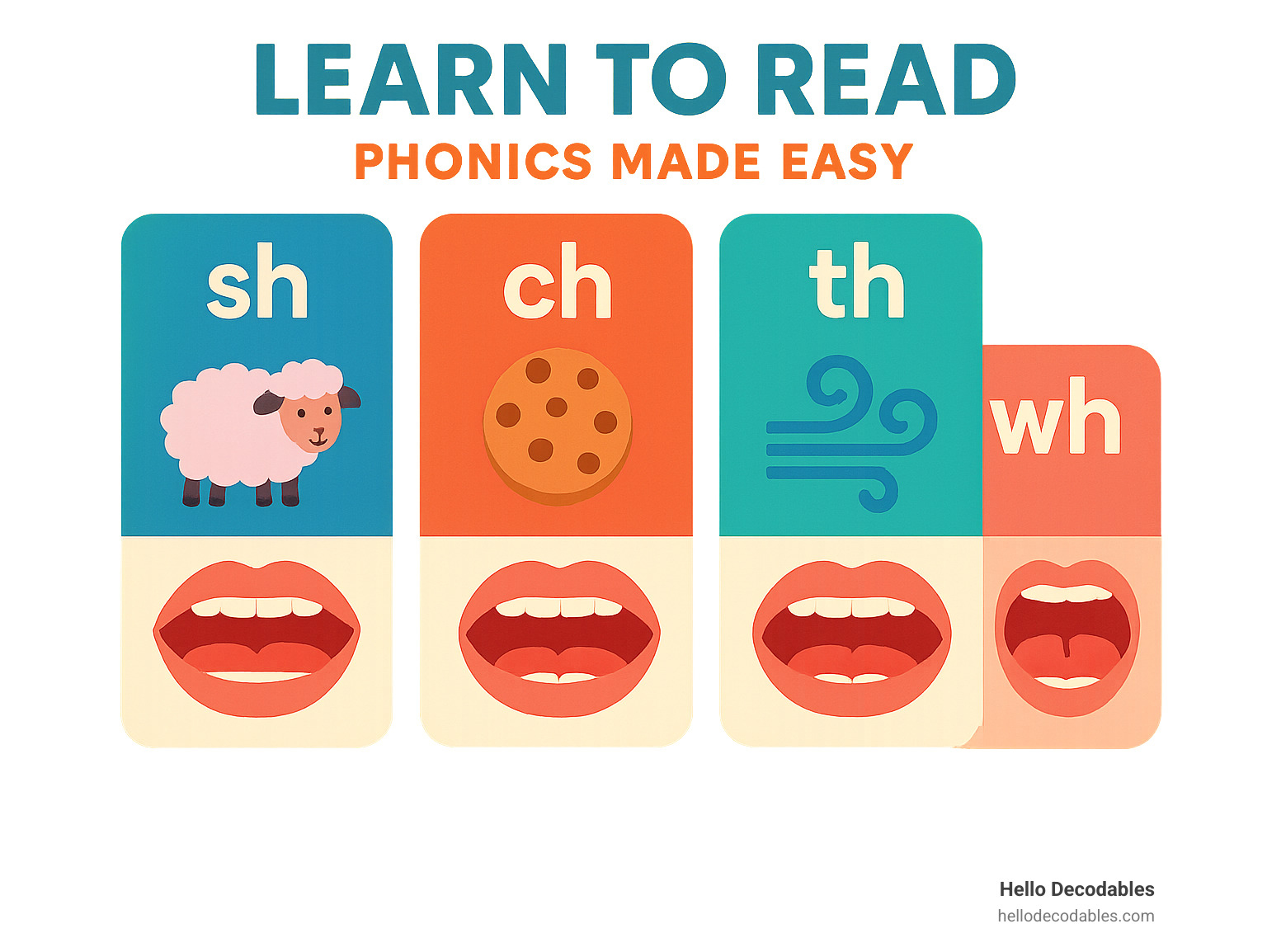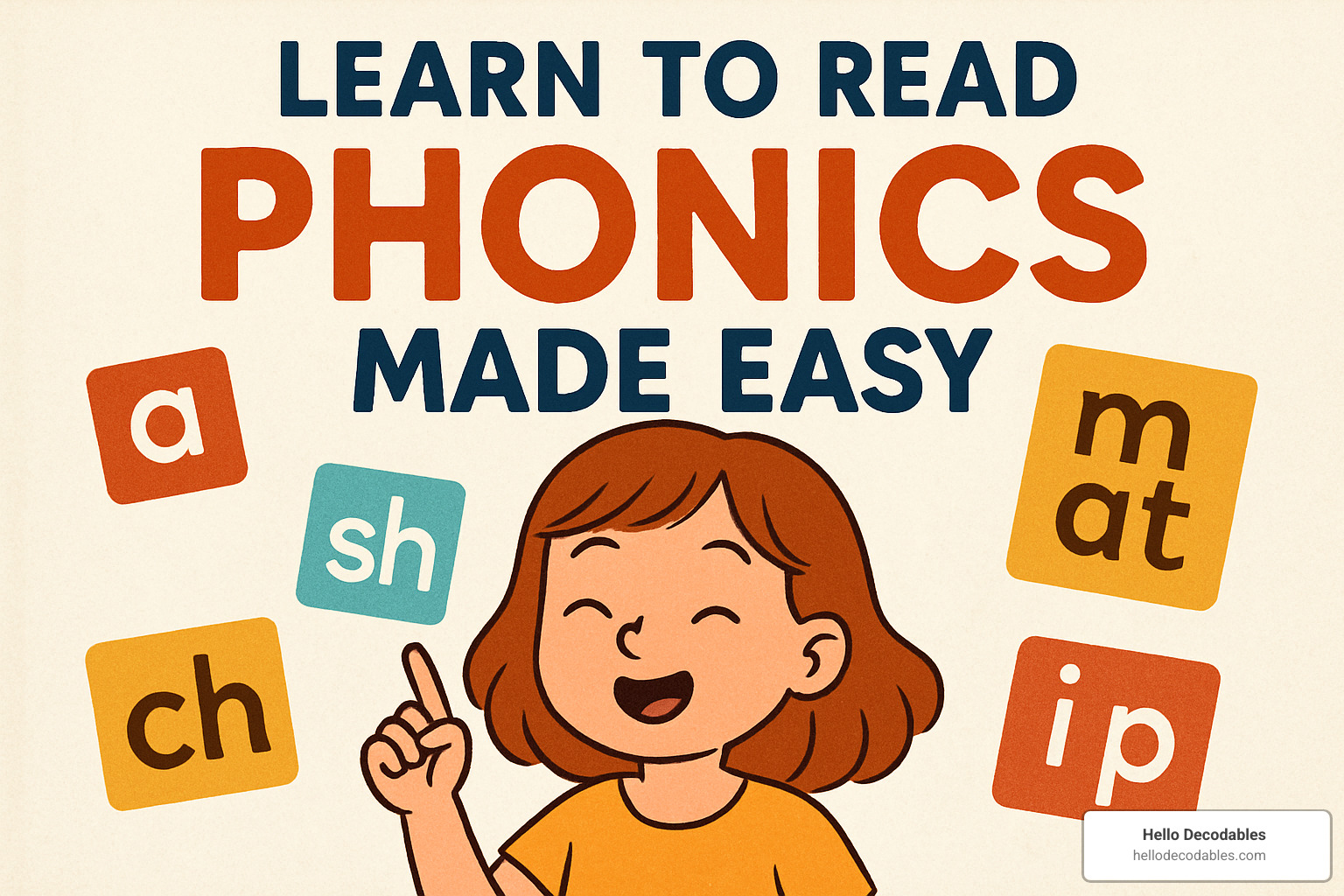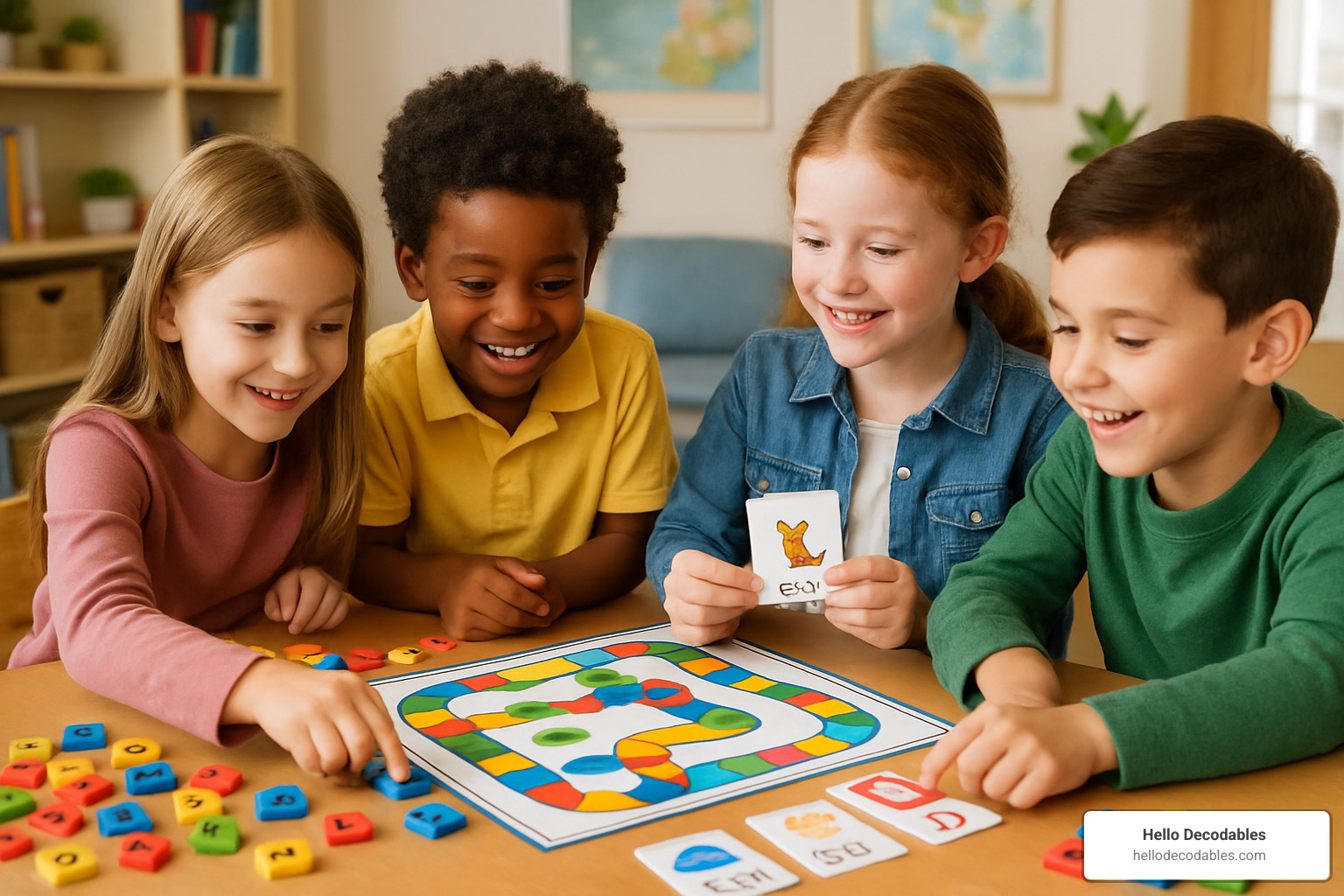
· By Jen Jones
From ABC to Easy: Mastering Phonics Without the Stress
Why Learning to Read Doesn't Have to Be Hard
Learn to read phonics made easy is possible when you follow a systematic, research-backed approach that breaks down reading into manageable steps. Here's what makes phonics instruction effective:
Essential Steps for Easy Phonics Learning:
- Start with letter sounds before letter names
- Practice blending simple CVC words (cat, dog, sun)
- Progress systematically through digraphs and vowel patterns
- Use decodable books that match your child's current skill level
- Make it fun with songs, games, and multisensory activities
Reading struggles don't have to define your child's educational journey. As Frederick Douglass once said, "Once you learn to read, you will be forever free." The key is finding the right approach that removes frustration and builds confidence from day one.
Phonics has been officially recognized in English-speaking countries like the United Kingdom and United States as the most effective method for teaching reading. Unlike other approaches that ask children to guess at words, phonics gives kids the tools to decode any word they encounter. This systematic method teaches the relationship between sounds (phonemes) and their written symbols (graphemes), allowing children to become independent readers.
Why does this matter for your struggling reader? Many children who seem "behind" in reading simply haven't been taught with a structured phonics approach. When kids learn to map sounds to letters in the correct sequence, reading becomes logical rather than mysterious.
I'm Jen Jones, a literacy expert with over 30 years in education and founder of Hello Literacy, where I've helped thousands of educators learn to read phonics made easy through evidence-based instruction. My Hello Decodables™ series is endorsed by The Reading League and has been adopted by schools across the United States and Canada for its systematic approach to building reading confidence. In this guide, I'll walk you through the exact steps that transform struggling readers into confident, independent learners.

Why Phonics Matters for Reading Success
Picture this: your child sits down with a book, and instead of struggling and guessing at words, they confidently sound out each one. That's the power of phonics in action. When we look at decades of brain research, the message is crystal clear—phonics isn't just another teaching method, it's the essential foundation that makes reading possible.
The Science of Reading has revolutionized how we understand literacy development. Researchers have found that successful readers must develop strong phonemic awareness—the ability to hear and manipulate individual sounds in spoken words—before they can effectively tackle written text. Think of it like learning to walk before you run.
Here's what makes phonics so powerful: it gives children a reliable system for decoding any word they encounter. Without systematic phonics instruction, kids are essentially playing a guessing game with text. With it, they have the tools to become independent readers who can tackle new words with confidence.
What Is Phonics and Why Is It Important?
At its heart, phonics is the relationship between sounds (what we call phonemes) and their spellings (graphemes). It's like building a bridge between what children already know—how to speak and understand language—and the mysterious world of written symbols on a page.
When we teach phonics systematically, amazing things happen. Children develop stronger pronunciation skills because they understand how sound patterns work in our language. Their spelling improves dramatically as they learn to encode words using the same sound-symbol relationships they use for reading.
But here's the real game-changer: when decoding becomes automatic, children's comprehension soars. Why? Because their brains aren't working overtime just to figure out what the words say—they can focus on understanding what those words mean. This leads to expanded vocabulary as children gain the confidence to tackle unfamiliar words independently.
Phonics vs. Other Methods
Not all reading approaches deliver the same results, and understanding the differences can save you months of frustration. Systematic phonics stands apart because it provides explicit teaching of how our writing system actually works.
| Method | How It Works | Strengths | Limitations |
|---|---|---|---|
| Systematic Phonics | Teaches sound-symbol relationships in a logical sequence | Gives children tools to decode any word; builds independent readers | Requires systematic instruction and practice |
| Whole Language | Children learn words by sight and context | Can be engaging with real literature | Leaves children guessing; doesn't provide decoding tools |
| Three-Cueing | Uses meaning, syntax, and visual cues to guess words | Emphasizes comprehension | Encourages guessing rather than accurate reading |
The difference is profound. While other methods ask children to memorize words or make educated guesses based on pictures and context, phonics gives them actual skills. It's the difference between giving someone a fish and teaching them to fish.
When children learn through balanced literacy that includes explicit phonics instruction, they develop both the technical skills to decode words and the comprehension strategies to understand meaning. This combination creates confident, capable readers who can handle any text that comes their way.
Learn to Read Phonics Made Easy: A Step-by-Step Roadmap
The magic of learn to read phonics made easy appears when instruction follows a clear, research-backed sequence. Think of it like building a house—you lay the foundation first, then add walls, then the roof.
Stage 1 – Alphabet & Simple CVC Blends
We start with letter sounds before letter names because sounds are what children actually use to read. Consonants such as m, s, t, p, n, r, d, h, c, k and short vowels create immediate reading success with words like cat and sun. Pair sound practice with multisensory activities—tracing letters in sand, using picture cues, or tapping out phonemes on fingers. Most children master this stage in 2-4 weeks; adults often need just 1-2 weeks.
Stage 2 – Digraphs, Consonant Blends, and Common Sight Words
Next, children crack the “secret codes” of English: digraphs (ch, sh, th, ng) and blends (bl, cl, br, dr). We also introduce a short list of high-frequency sight words such as the and of. Mastery typically takes 3-6 weeks and instantly multiplies the number of readable words.

Stage 3 – Long Vowels, Magic-e, and Vowel Teams
Silent-e “magic” and vowel teams (ai/ay, ee/ea, oi/oy) open up thousands of new words. Children read controlled sentences that use only the patterns they know, ensuring success instead of guesswork. Expect 6-10 weeks of practice here.
Stage 4 – Multisyllabic Words & Reading Fluency
Now students shift from "learning to read" to "reading to learn." They divide syllables (rab-bit, cup-cake), add common suffixes (-ing, ‑ed, ‑er), and work toward fluent, expressive reading—about 60 WPM by the end of 1st grade, 90 WPM by 2nd, and 110 WPM by 3rd.

How Long Until Fluency?
• Adults/teens: fluent in 1-3 months with daily practice.
• Children 5-7: 6-12 months of systematic lessons.
• Older struggling readers: 4-8 months to fill gaps and gain speed.
Progress isn’t about racing—it’s about building rock-solid skills that last a lifetime.
Tools & Resources for Stress-Free Phonics Practice
You don’t need pricey gadgets to make phonics stick—just engaging materials that match a learner’s current skill set.
Top Free & Low-Cost Resources
- Phonics.com – colourful interactive lessons.
- ABC Fast Phonics Tutorial – click-to-hear examples for independent practice.
- SWIFT Phonics Programme – printable flashcards in a 17-step sequence.
- Starfall – free decodable texts and games.
- Phonic Books – sample decodable readers aligned to each new pattern.
More guidance: Learn to Read with Phonics, Fluency, and Comprehension.
Best Books & Apps
Premium options that consistently deliver results:
- Reading Made Easy With Phonics 1 – popular with adult and teen learners.
- Phonic Books Series – gold-standard decodables.
- The Phonics App – teaches A-Z sounds free; 400+ decodable words with subscription.
- Hello Decodables Series – our Science-of-Reading-aligned books used in classrooms across the U.S., Canada, and Australia.
Full comparisons: Phonics Books: Your Best Bets for Boosting Reading Skills.
Making It Fun: Games, Songs, Interactive Activities
- PhonicsMonsters.com turns sound practice into an trip with music and mini-games.
- Scavenger hunts – find household items that start with /s/ or /m/.
- Letter-sound bingo and magnetic-letter word building keep hands busy while brains learn.

Troubleshooting Common Challenges & Adapting for All Learners
Let's be honest—even with the best phonics instruction, some children hit bumps along the way. These challenges aren't signs of failure; they're normal parts of the learning process that require a little extra patience and creativity.
Overcoming Specific Problems
Letter reversals are probably the most common concern parents bring up. Seeing b's and d's flip-flopped, or p's and q's dancing around the page, can feel alarming. But here's the reassuring truth: letter reversals are completely normal for beginning readers and usually resolve themselves with time and practice.
The key is using multisensory approaches that help children feel the difference between letters. Try having your child trace letters in sand or salt while saying the sound out loud. Making letters with play dough gives their hands muscle memory for each shape.
Blending confusion stumps many children who can say individual sounds perfectly but struggle to push them together into words. It's like knowing all the ingredients for a recipe but not quite understanding how to mix them together.
Start with continuous sounds like /m/, /s/, and /f/ because they're easier to stretch and blend than quick sounds like /t/ or /p/. Use physical gestures like "sound buttons"—touching each finger as you say each sound, then sliding your finger along to blend them together.
Irregular sight words can frustrate children who've learned to trust the phonics code. Words like "said," "was," and "the" seem to break all the rules they've worked so hard to master. The trick is being upfront about it: "This word is a rule-breaker, so we need to memorize it."
Use explicit memorization techniques like flashcards, but also highlight the regular parts of irregular words. In "said," the /s/ and /d/ follow the rules—only the middle part is tricky.
Multisensory learning hacks work wonders for children who need extra support. Visual learners benefit from color-coding vowels in red and consonants in blue. Auditory learners love singing phonics songs and creating sound effects for different letters. Kinesthetic learners need to move—try sky-writing letters in the air or using hand motions for each sound.
For detailed strategies that address these specific challenges, our comprehensive guide Phonics Made Easy: Proven Strategies for Teaching Success offers proven techniques that work in real classrooms.
Measuring and Tracking Progress
Here's something that might surprise you: progress monitoring doesn't have to be stressful or time-consuming. In fact, the most effective assessments are often the simplest ones that give you clear, actionable information about what's working and what needs adjustment.
Running records give you a window into your child's reading process. Simply have them read a decodable passage aloud while you jot down any errors or self-corrections. This shows you both accuracy and whether they're understanding what they read.
Phonics inventories test specific sound-symbol relationships systematically. Many phonics programs include built-in assessments for each level, making it easy to see exactly which sounds your child knows solidly and which ones need more practice.
Fluency measures show whether decoding is becoming automatic. Time your child reading grade-level passages and track words per minute over time. But remember—accuracy comes before speed.
Visual progress tracking can be incredibly motivating. Chart systems like those used in systematic programs help children see exactly where they are and what comes next.
The key to effective progress monitoring is keeping it frequent but brief—5 to 10 minutes is plenty. Focus on accuracy before speed, celebrate small wins to maintain motivation, and most importantly, adjust your instruction based on what the assessments tell you.
For practical assessment tools and ready-to-use materials, explore our collection: Boost Reading Skills with These Phonics Decodable Passages. These passages are specifically designed to match children's phonics knowledge, making assessment both accurate and encouraging.
Every child's learn to read phonics made easy journey looks different. Some sprint through certain stages while taking their time with others. The goal isn't perfection—it's progress, one sound at a time.
Frequently Asked Questions about "Learn to Read Phonics Made Easy"
How can parents support phonics at home without formal training?
- Teach sounds first. Say “/mmm/” for m instead of naming the letter.
- Follow one sequence. Pick a reputable program and stick with its order.
- Keep sessions short (10–15 min). Daily consistency beats marathon lessons.
- Make it multisensory. Write letters in sand, use fridge magnets, or sing vowel songs.
- Use decodable books that only include patterns your child knows.
What makes decodable books different from leveled readers?
Decodable books are controlled so every word can be sounded out with taught phonics patterns. Leveled readers may include untaught words, forcing guesswork. Decodables build accuracy and confidence; leveled texts are better once decoding is automatic.
Our Hello Decodables series ensures each story matches the exact skills students have just learned—no surprises, no guessing.
Can adults really become fluent readers with phonics in a few months?
Yes. Adults already know the meanings of most words—they just need to map sounds to print. Programs such as Reading Made Easy With Phonics report fluency gains in 1–3 months when learners practice daily and master each step before moving on.
Conclusion
Systematic phonics is reliable because it mirrors how the brain processes written language. When instruction is explicit, sequential, and paired with decodable texts, even struggling readers can achieve fluency in months—not years.
Hello Decodables follows this evidence-based model. From Greenville, NC, to classrooms across the United States, Canada, and Australia, we’ve seen learners light up when they realise, “I can read this myself!”
Ready for next steps? Explore Phonic Decoding Unveiled: Techniques and Tips for Effective Learning and start your own success story today.
"Once you learn to read, you will be forever free." —Frederick Douglass
